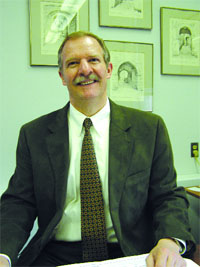
Keeping an i on Learning AICs New MBA Comes with a High Degree of Individuality

John Rogers says the ‘hybrid’ nature of the iMBA program at AIC offers participants “the best of both worlds.
Its called the iMBA.
And the i, in this case, stands for individualized, said John Rogers, dean of the School of Business Administration at American International College, who told BusinessWest that the latest addition to the schools portfolio of MBA products speaks loudly as to where he and many others believe higher education is heading and in several respects.
This is a hybrid program, Rogers explained, adding that it blends the convenience of online learning with what he considers the very necessary (especially in business education) interaction between students and the instructor.
The general feeling is that online education has been efficient, its user-friendly, and the logistics are right, but in an MBA program, youre teaching people how to be business leaders, and you cant develop those skills needed to be a business leader if you never see anyone face-to-face, said Rogers, adding that iMBA participants are in class for one weekend each month for what he called interactive seminars.
But thats not what makes the program truly unique, Rogers continued, noting that hybrid programs are fairly common. Instead, its how the iMBA system adjusts to each students learning style and preferences. Elaborating, he said the new MBA incorporates the so-called Adaptive Learning Model developed by AICs partner in this venture, IDL Systems of Cambridge, and its founder, Dr. Nish Sonwalker of MIT. The ALM allows students to optimize their time in class, Rogers explained, by helping them to master key concepts through online exercises tailored to each students learning style.
The most effective teaching comes when you beam your content in such a way that the individual is receiving it in accordance with his or her preferred learning style, he said, going on to list several, including apprenticeship, or learning by watching and doing; deductive learning, in which students are given basic principles that are then worked down to specifics; inductive learning, involving such things as case studies; and the discovery method very few people actually read the Microsoft Office manual, said Rogers;they just say, let me get on the computer and play with the software, and thats how Ill learn.
Essentially, the ALM gauges how a student can best learn the material being taught in a given course, and adapts, hence the name, to focus on the most appropriate one for a given individual.
As an example of how it works, Rogers offered some subject matter, specifically, the time value of money. Some people will get that concept and how to work with it through the direct, deductive approach, he explained, while others will need some examples, and still others will discover it by playing with different scenarios, such as, if I put money in the bank, whats it worth after five years, 10 years, or 20 years? and theyll come up with an understanding.
Overall, this process is inclusionary, rather than exclusionary, he continued, adding that, in the traditional methodologies, an instructor will test individuals, and some will fail. In this system, we keep trying new methods until full mastery of a topic is achieved; some people will take longer than others, and some people will need to experiment with different learning styles before they get it but eventually, theyll get it.
Rogers said this is the direction in which higher education is heading a place where instructors dont simply teach a subject and hope that a student will achieve mastery of it, but will instead have a form of verification that they have indeed learned. This will ultimately help students be better-prepared for the workplace and the business world, he said.
And the key, again, is the coupling of the hybrid methodology with the adaptive- learning system.
If you do the hybrid program right, you get the best of both worlds; you get the convenience of online learning, but you can leverage the technology and use it in creative ways such as the adaptive-learning model, where you can teach more effectively and get higher success rates, he said, noting that completion, or success, rates with online learning are traditionally about 50%, while programs like the iMBA run closer to 90%.
Thats because you can bring people together, and get that face-to-face bonding with the instructor, he continued. Most people need that; they dont need it every week, necessarily, but they need that component.
AIC is of several institutions now partnering with IDL Systems, including Boston University, the University of Dallas, and the Department of Defense, said Rogers, adding that he believes the iMBA will become a popular addition to AICs suite of products because of its structure, flexible scheduling, pace (students earn in an MBA in one year as opposed to two to three years in a traditional part-time program), and other qualities.
Introduced earlier this spring, the iMBA program involves groups of students, or cohorts, said Rogers. The first one included 12 individuals, and the preferred size would be 15 to 20. Those in these cohorts are predominantly young people in business, perhaps five to seven years removed from their undergraduate degree, who are in management or on their way there.
This is essentially another delivery system for the MBA, he said, adding that he believes it will appeal to those who dont live near the campus, need flexibility in their schedules but have the ability to commit one full weekend a month, or who simply want something different, in this case the ALM model.
Were taking the technology platforms and using them at a higher level, he continued, noting that the iMBA goes a step above most distance learning programs now offered at a host of schools. Everyone learns differently and at different speeds. This unique model recognizes this and adjusts to fit each student.
And this, he said, is the real meaning of individualized.
George OBrien






